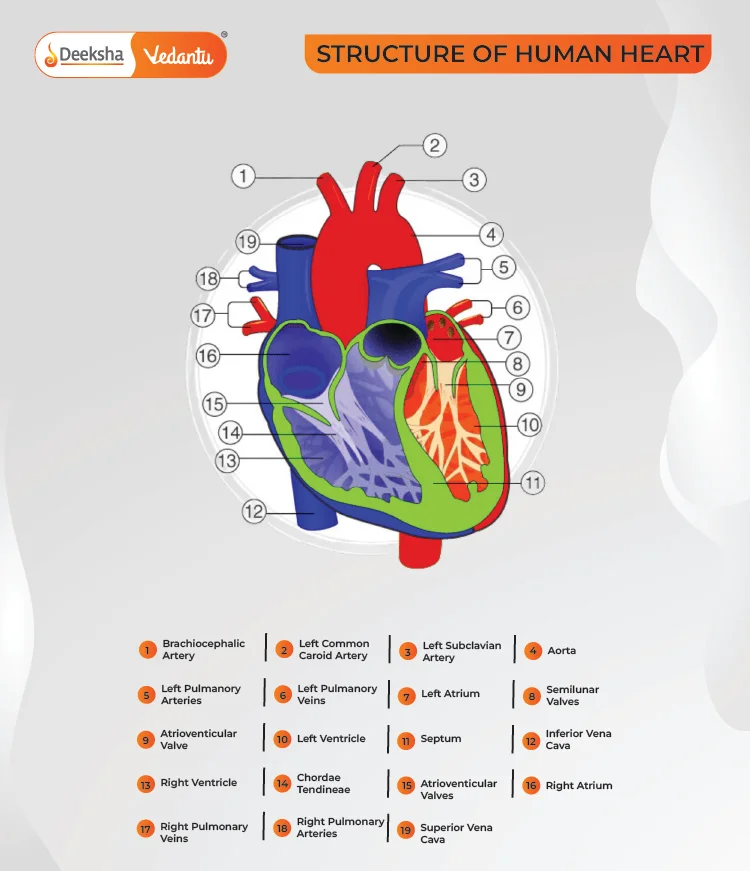Introduction to the Human Heart
The human heart is a vital organ responsible for pumping blood throughout the body, a process essential for providing nutrients and oxygen to tissues and removing carbon dioxide and other wastes. This muscular organ is roughly the size of a clenched fist and is located in the thoracic cavity between the lungs, slightly offset to the left side of the sternum.
Structure of the Human Heart

The heart is a four-chambered muscle with two atria and two ventricles. Here’s a closer look at its structure:
- Right Atrium and Ventricle: These form the right side of the heart, receiving deoxygenated blood from the body and pumping it to the lungs for oxygenation.
- Left Atrium and Ventricle: These make up the left side, receiving oxygenated blood from the lungs and pumping it to the rest of the body.
- Valves: The heart features four main valves that prevent the backward flow of blood, ensuring it moves correctly through the heart and into the major arteries.
Position and Function of the Heart

Positioned centrally but tilted towards the left chest, the heart’s primary function is circulatory:
- It maintains blood flow through pulmonary (lungs) and systemic (body) circulations.
- Supplies oxygen and nutrients to tissues.
- Helps in removing metabolic wastes.
Circulatory Systems Involving the Heart
- Pulmonary Circulation: Moves blood between the heart and lungs.
- Systemic Circulation: Distributes blood to all body parts except the lungs.
- Coronary Circulation: Supplies blood to the heart itself, crucial for its own oxygen and nutrient needs.
Detailed Heart Anatomy
External Structure:
- Pericardium: A double-layered membrane that surrounds and protects the heart.
- Epicardium, Myocardium, and Endocardium: These three layers respectively form the outer layer, muscular middle layer, and inner lining of the heart chambers.
Internal Structure:
- Chambers: Includes two upper chambers (atria) and two lower chambers (ventricles).
- Valves: Tricuspid, pulmonary, mitral, and aortic valves control blood flow through the heart’s chambers and into major arteries.
The Heart’s Role in the Body
The heart is not just an organ but a crucial component of the circulatory system, ensuring the movement of blood rich in nutrients and oxygen to cells throughout the body. It works relentlessly, beating about 100,000 times a day, pumping liters of blood to sustain life functions.
Understanding the human heart’s structure and function helps us appreciate how vital this organ is to our overall health and well-being. Whether you’re a student, educator, or just curious about the body’s workings, recognizing the heart’s role illuminates the importance of maintaining cardiovascular health.
FAQs
The heart ensures all bodily tissues receive adequate oxygen and nutrients and helps in the removal of metabolic wastes, which is crucial for maintaining overall health.
The heart is involved with pulmonary circulation (between the heart and lungs), systemic circulation (throughout the body), and coronary circulation (blood supply to the heart itself).
The heart is located in the middle of the thoracic cavity, between the lungs, slightly tilted towards the left.
The human heart has four chambers: two atria on the top and two ventricles on the bottom.
The main function of the human heart is to pump blood throughout the body, facilitating the circulation of oxygen, nutrients, and the removal of wastes.
Related Topics
- How do Organisms Reproduce?
- Rainwater Harvesting
- Types of Pollution
- Control and Coordination
- What Are Life Processes?
- Coordination In Plants
- Mitochondria
- How Do Our Activities Affect The Environment?
- Mitosis And Meiosis
- Kingdom Fungi
- Accumulation Of Variation During Reproduction
- Heredity Traits
- Biology FAQs
- Cell Organelles
- Nitrogen Cycle












Get Social